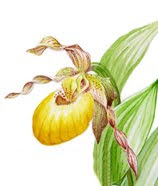I am expecting to see orchids soon in all their various habitats, since the common spiranthes is up about half an inch in my prairie patch. Their parallel-veined leaves, slightly recurved at the tip, give them distinction from grasses and sedges and members of the lily tribe. Some leaves are very smooth, even waxy, others slightly pubescent (those being mostly the ladyslippers, whose tiny hairs often contain a chemical irritating to the skin, to ward off predators. Despite that, unfortunately, they are all 'deer candy'.
Three paintings were exhibited this spring at the former Brushwood estate of the Ryerson family, now an education center for the Lake County Forest Preserve. I painted three species native to Lake County: Platanthera psycodes, the purple fringed orchid; Mitella diphylla, also known as bishop's cap, for the curious shape of its seed pods; and Asclepias exaltata, the poke milkweed, an undisputedly ugly name for a lovely woodland milkweed. The exhibit was organized by my dear colleague Ann Gilna for our Reed-Turner Woodland chapter of the American Society of Botanical Artists. Derek Norman, head of the Midwest Center for Botanical Documentation, is the president of our group. He used to be head of the Chicago Botanic Garden corporate design team before he retired and is now on staff there teaching several botanical art courses. Quite amazing work, that! I have not studied with him tho am sure I would enjoy the privilege. The exhibit represented species native to northern Illinois as well as some tropical plants. I prefer the natives, simply because a close look reveals hidden treasures, and many people are not familiar with them.
I came across A. exaltata a couple of years ago when out in the woods botanizing with my mentor John Banaszak. He pointed out the plant to me and said that if the buckthorn was cleared from there to open up the savannah a bit, we'd see more of the plant, and if we didn't, we would lose the species from the site. So restoration was scheduled for that winter, clearing out the brush and carefully herbiciding the stumps of the buckthorn and honeysuckle bushes that were starting to take over the black ash/swamp white oak flatwoods. The following summer, instead of two plants, there were several. And one of them had seedpods, so I have great hope that we will continue to see the population increase.
Habitat restoration is important. Sure, I adore orchids; how can you not? - they're SO cute! But they're also the 'canaries in the mine' for habitat and water quality. When the orchids disappear from a site, you know that there are changes, visible or invisible, that are making the site inhospitable to them. Some of these changes might be changes in hydrology, especially lowering of the water table, since orchids are dependent on fungi in the soil and the fungi seem to be pretty specific in their moisture needs. (I need to research that further but that's what staff at the CBG tell me) Another change is incursion of non-native species such as reed canary grass, buckthorn, honeysuckle or garlic mustard. The garlic mustard is especially insidious, since it contains an anti-fungal chemical which is deadly to the essential but delicate fungal network in the soils of high-quality woodlands and prairies. (I found a sneaky overwintering rosette yesterday in my yard - AAAGH! - they can be very difficult to remove by the roots, but that's what you have to do.) Quite a bit of my 'discretionary time' which heretofore had been spent painting orchids is now devoted to restoring habitat so that there will be orchids there next year, and the next, and maybe for hopefully many years to come.
This year I hope to be monitoring four species of native orchids, and several other species besides, for Plants of Concern. I also hope to get out to see the extremely rare Calopogon oklahomensis. Stay posted for new images from my field trips, and new paintings.
Thursday, April 24, 2008
Subscribe to:
Post Comments (Atom)

No comments:
Post a Comment